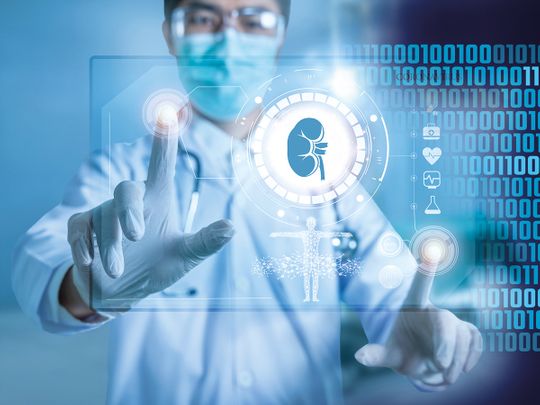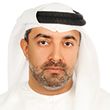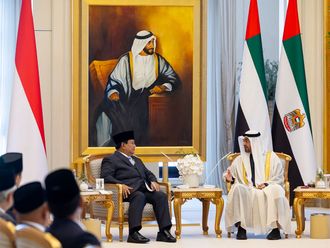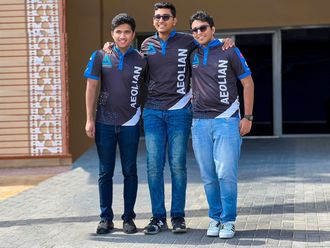
As the UAE’s largest healthcare network, Abu Dhabi Healthcare Services (SEHA) is privy to sizeable amounts of data on specific diseases affecting residents across the emirate and their impact. But with great amounts of data comes a big responsibility to contextualise and parse the information, and that’s where Cerner and its smart electronic medical records (EMRs) come into play, particularly in the case of treating acute kidney injury (AKI).
Use of AI in diagnosis
“EMR in SEHA, which is supplied by Cerner, holds lots of patient data,” says Dr Ali Al Obaidli, Chief Medical Officer at SEHA Kidney Care. “EMR is now no longer just used for billing purposes and recording data and is increasingly used to help support doctors to make better decisions.”
It’s actually a form of artificial intelligence (AI), believes Dr Al Obaidli, because you can feed it rules and algorithms to pick up certain diseases earlier.
Cerner, a US company listed on Nasdaq that has built IT and other technology solutions in the healthcare sphere for more than four decades, has a presence in almost every major healthcare system in the Gulf, as well as hundreds of UK and US hospitals. “What it means is that now we have access to valuable information,” explains Dr Yasir Khan, Senior Physician Executive at Cerner Middle East and Africa. “This allows gathering and analysing data to observe the patterns in large sets.”
SEHA Kidney Care is one such example of a healthcare organisation that is using its patients data to help model its services. It’s one of the largest integrated renal care providers in the GCC region.
“SEHA Kidney Care is undergoing a transformation in the way we provide care in Abu Dhabi – we call it integrated renal care, which means that we have a comprehensive service with the goal to provide all renal services under one organisation,” explains Dr Al Obaidli.

SEHA Kidney Care is undergoing a transformation in the way we provide care in Abu Dhabi – we call it integrated renal care, which means that we have a comprehensive service with the goal to provide all renal services under one organisation.
With the rapid development of the UAE as a nation, people are living much longer than they were 50 years ago, says Dr Al Obaidli. However, with the change in lifestyle and ageing population, diseases such as diabetes and hypertension are also on the rise, and this predisposes people to develop kidney disease.
Several of the risk factors for renal diseases are modifiable including diabetes, hypertension and obesity, and Dr Al Obaidli says EMRs are increasingly becoming capable of delivering long-term predictive models of a patient’s risk of progressing into chronic kidney disease.
“The kidney is an organ that helps maintain what we call homeostasis, the natural physiological balance in our body, because it helps regulates salt and water balance,” explains Dr Siddiq Anwar, Consultant Nephrologist at SEHA. “AKI is where your kidneys suddenly stop working properly. An AKI does not just occur due to a disease native to the kidney, but as a complication of another serious illness. AKI is classified in stages one through three, based on the rise of creatinine level, a blood test used to monitor kidney functions. Increasing stage of AKI indicates severity and worse prognosis.”
Mitigating risks
One of the aims of Cerner’s e-alert system is to eliminate preventable deaths from AKI.
“If you get an AKI in, for example, an orthopaedic or cardiology ward, [the e-alert] will help those physicians, especially non-specialist physicians, recognise that the kidney is under stress,” explains Dr Anwar. “It will also help highlight that this patient’s overall condition has worsened because of the primary disease, as development of an AKI in hospital is a poor clinical sign.

If you get an AKI in, for example, an orthopaedic or cardiology ward, [the e-alert] will help those physicians, especially non-specialist physicians, recognise that the kidney is under stress.
“If you look at any early warning score, such as the sepsis or liver severity scores, a significant component of those scores is deteriorating kidney function. It’s well recognised that if your kidney function deteriorates in hospital, your risk of dying because of your primary disease goes up exponentially.”
The algorithm being used in SEHA has been adapted from the one built by Cerner for the UK’s NHS. “What this algorithm does is for anyone who is hospitalised, if there is an increase in creatinine, it goes back to see what their baseline is and stages them into an AKI stage one, two or three as per our international society’s guidelines,” says Dr Anwar. This helps the physician recognise deterioration of kidney function early, allowing for earlier intervention so that a patient does not end up requiring dialysis.
“The beauty of SEHA’s EMR is that all the hospitals, from primary to tertiary care, are on one electronic medical record,” he adds. If a patient has done a blood test at some point in Abu Dhabi, SEHA has a record of their kidney function test. If that patient later has a kidney injury in hospital, the algorithm automatically goes back to their baseline, compares, and can alert the physician that this patient’s kidney function has worsened. “This will help the physician make better clinical decisions.”
Dr Khan says that with modern EMRs capturing a patient’s entire medical journey, from admission to discharge, Cerner is able to develop intelligent algorithms capable of understanding variations in disease processes and suggest early interventions to physicians at an unprecedented scale.
One of the good practical examples is where a physician, while treating a patient diagnosed with chronic heart failure, is alerted that a prescribed medication may be harmful to kidneys, therefore an alternative should be considered. This strategy can dramatically reduce the patient’s risk of developing an AKI.
“By a combination of analytics, clinical disease support and just by virtue of having visibility across the entire patient journey, EMRs have evolved from a tool to a strategy to introduce better, safer and more efficient care.”

By a combination of analytics, clinical disease support and just by virtue of having visibility across the entire patient journey, EMRs have evolved from a tool to a strategy to introduce better, safer and more efficient care.
Dr Anwar further elaborates on how the data generated by the AKI algorithm will help SEHA tailor its renal services.
“Those patients who developed AKI will be at risk of developing chronic kidney disease and they will need surveillance in renal clinics. In addition, due to the nature of the patients’ case mix they look after, those clinical areas that have higher incidence of AKI will require more resource allocation.” Hence data analytics is increasingly shaping how healthcare service is evolving.
What’s next?
Intelligent algorithms being developed have the potential to transform both diagnosis and treatment, says Dr Khan. “On the diagnostic side, there are algorithms that are analysing radiological images and diagnosing cancers far quicker and more accurately than a human counterpart can do. I see significant investment going into image diagnostic-related AI and machine learning.”
With Covid-19, telemedicine has finally gone mainstream. As more patients with chronic conditions are being managed remotely at home, extensive data from connected devices such as glucometers will feed into EMRs, which can predict an event before it occurs, adds Dr Khan.












